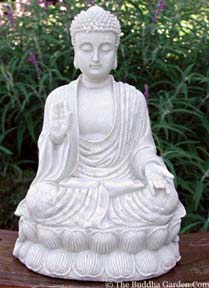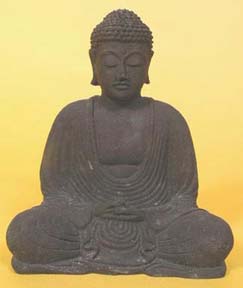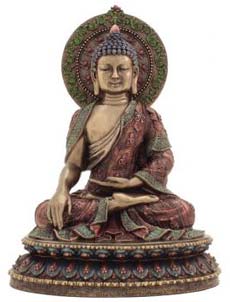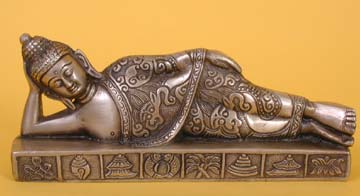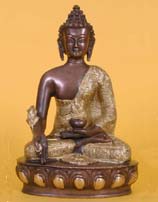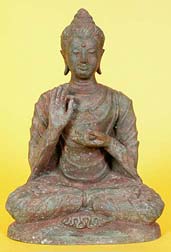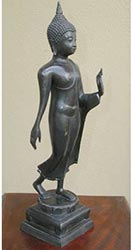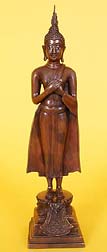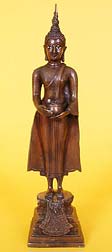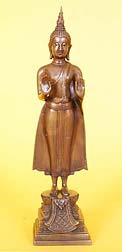If you know what to look for, you can tell the meaning of a Buddha
Statue by looking at the pose / posture, and the accompanying hand
gestures. Each traditional pose has a significance related to an
important event in the the life – or past lives – of the Historical
Buddha. (Note: You can see more examples by Visiting our Buddha Statues For Sale Page on this site.)
Also referred to as an asana or an Attitude, there are over 100 poses illustrating the life of the Buddha. And each posture will have a specific hand gesture, called a Mudra, associated with the posture. In general, the carvings of the Buddha that you can buy are representations of highly venerated statues that are enshrined at major temples throughout the world, or are reproductions of well known sculptures that were originally commissioned by royal patrons, and as such, their meanings and significance are similar to the original statues.
The main features of this pose, aside from the raised right hand, is that The Buddha can be depicted either sitting or standing, and the left hand may either be extended outward or palm up in the lap. This statue signifies courage and offers protection from fear, delusion and anger.
In this pose, the Buddha is depicted with both hands in the lap, face up, and the legs are crossed, either in a Double Lotus pose (with the ankles of each leg tucked behind one another in a locked position), or in a Single Lotus pose (where one leg rests on top of the other leg). Occasionally, an alms bowl is placed in the lap as well.
As this statue generally represents focused concentration, the eyes of the Buddha are either depicted as halfway closed, or closed nearly all the way. The silhouette of the statue is shaped – more or less – like a triangle, which represents stability.
Many of the largest Buddha Statues in Japan, such as the Great Kamakura Buddha Statue at Kotokuin Temple, and large statues in Korea are in the Meditation Pose. This pose is also known as the Amithabha Buddha, which means “Boundless Light.”
It is the story of how the Buddha, after six years, finally was at the verge of enlightenment. Unfortunately Mara, the Demon of Illusion, tried to dissuade The Buddha from the final last steps. The Buddha meditated all night to overcome the fears and temptations sent by Mara, and then called the Earth Goddess to witness that the Buddha achieved enlightenment in order to share with the rest of the world. Witnessing that, the Earth Goddess wrung her hair, releasing flood waters that swept away the Demon Mara and all the temptresses he had released.
Because the Buddha had gained enlightenment in this lifetime, the Buddha was able to escape the endless cycle of birth – death – rebirth (known as samsara) and was able to enter Nirvana. In this pose, the Buddha is always depicted lying on the right hand side on top of a resting table. One of the most well-known examples of this statue is enshrined at Wat Pho in Bangkok, Thailand, although there are numerous other temples throughout Southeast Asia that house statues in the posture.
It is believed by the Tibetans that the Buddha was responsible for delivering the knowledge of medicine to the people of the world, and in fact the right hand facing outward signifies “granting a boon” (meaning, giving a blessing) to mankind. This is a common hand gesture amongst both Buddhist and Hindu statues.
The Medicine Buddha is venerated by those seeking health, and is more commonly found in the Buddhist temples and communities of Nepal and Tibet.
As do most images of the Buddha, the Teaching Buddha depicts a particular moment in the life of the Buddha, namely, the first sermon the Buddha gave after reaching Enlightenment. This sermon was to a small group of disciples who had previously scorned the Buddha. This is a statue that is particularly appropriate for those who are either studying or are interested in learning more about spirituality.
The phrase DharmaChakra is hard to translate. The word Dharma means “the way of righteousness,” while the word Chakra is usually translated as the “Universe” or as the “cosmos.” Taken together, this phrase generally is interpreted as, “putting the cosmic law of righteousness in order,” or “turning the wheel of cosmic righteousness.”
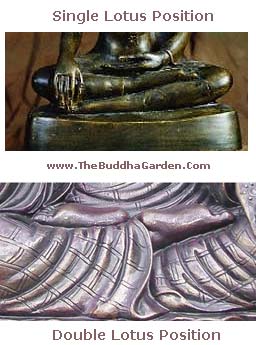
In general, the Buddha is depicted as sitting with the legs crossed.
This makes a “triangle” shape to the image; the knees making the two
bottom points of the triangle shape, while the tip of the head makes the
top point of the triangle. The significance is that a triangle shape is
more “grounded” or has a more solid foundation.
There are two positions for crossed legs, namely with the right leg resting above the left leg in the Single Lotus Position, or with both knees pointing downward and the ankles tucked on top of one another in the Double Lotus Position.
But there are a few postures that are not seated with crossed legs, namely the Maitreya Buddha, where the “Buddha of the Future” sits in a chair Western style. Also, there is a story of how a monkey and an elephant visited to make offerings to the Buddha, and in those images he is depicted sitting in a chair as well. there are standing Buddhas, and in Thailand, one of the most beloved forms is of the Walking Buddha statue, which is exclusive to the Sukhothai period of Thai art.
Also referred to as an asana or an Attitude, there are over 100 poses illustrating the life of the Buddha. And each posture will have a specific hand gesture, called a Mudra, associated with the posture. In general, the carvings of the Buddha that you can buy are representations of highly venerated statues that are enshrined at major temples throughout the world, or are reproductions of well known sculptures that were originally commissioned by royal patrons, and as such, their meanings and significance are similar to the original statues.
Protection Buddha / Overcoming Fear
This depiction of a seated Buddha with the right hand raised and facing outwards has two common meanings. The first is that of the Protection Buddha, as the raised right hand symbolically represents a shield. The second meaning, Overcoming Fear, is closely related to the first (since one who is receiving protection would be less fearful).The main features of this pose, aside from the raised right hand, is that The Buddha can be depicted either sitting or standing, and the left hand may either be extended outward or palm up in the lap. This statue signifies courage and offers protection from fear, delusion and anger.
Meditation Buddha / Serenity Buddha / Calming Buddha
Another of the more common rupas is of the Buddha in Meditation. This statue is for people who are either looking for peace and clam in their lives, or for those who wish to improve their own meditation skills. People will often buy a Meditation Buddha if they want to set up a “serenity room” or a corner of their house where they can sit in calm for a little while and unwind.In this pose, the Buddha is depicted with both hands in the lap, face up, and the legs are crossed, either in a Double Lotus pose (with the ankles of each leg tucked behind one another in a locked position), or in a Single Lotus pose (where one leg rests on top of the other leg). Occasionally, an alms bowl is placed in the lap as well.
As this statue generally represents focused concentration, the eyes of the Buddha are either depicted as halfway closed, or closed nearly all the way. The silhouette of the statue is shaped – more or less – like a triangle, which represents stability.
Many of the largest Buddha Statues in Japan, such as the Great Kamakura Buddha Statue at Kotokuin Temple, and large statues in Korea are in the Meditation Pose. This pose is also known as the Amithabha Buddha, which means “Boundless Light.”
Calling The Earth To Witness / Earth Touching Buddha
The most common pose you will find in Thai temples is with the legs crossed, the left hand in the lap, and the right hand pointing to the ground with the palm facing inward toward the Buddha. This posture is known as Calling The Earth to Witness, and it is the definition of the moment of enlightenment for the Buddha.It is the story of how the Buddha, after six years, finally was at the verge of enlightenment. Unfortunately Mara, the Demon of Illusion, tried to dissuade The Buddha from the final last steps. The Buddha meditated all night to overcome the fears and temptations sent by Mara, and then called the Earth Goddess to witness that the Buddha achieved enlightenment in order to share with the rest of the world. Witnessing that, the Earth Goddess wrung her hair, releasing flood waters that swept away the Demon Mara and all the temptresses he had released.
The Nirvana Buddha / Reclining Buddha
This statue depicts the Historical Buddha in the last moments of life on earth, prior to the Buddha dying one last time before entering Nirvana (often written in English as ParaNirvana when referring to the life of The Buddha). It is said that an alms giver had accidentally given the Buddha pork that had gone bad, and this eventually led to the death of the Buddha.Because the Buddha had gained enlightenment in this lifetime, the Buddha was able to escape the endless cycle of birth – death – rebirth (known as samsara) and was able to enter Nirvana. In this pose, the Buddha is always depicted lying on the right hand side on top of a resting table. One of the most well-known examples of this statue is enshrined at Wat Pho in Bangkok, Thailand, although there are numerous other temples throughout Southeast Asia that house statues in the posture.
Medicine Buddha
The Medicine Buddha is depicted in paintings having blue skin, but whether shown in statue or painted form, the right hand is held facing downward with fingers extended toward the ground, palm facing outward toward the viewer, a bowl of herbs rests in the left hand upon the lap.It is believed by the Tibetans that the Buddha was responsible for delivering the knowledge of medicine to the people of the world, and in fact the right hand facing outward signifies “granting a boon” (meaning, giving a blessing) to mankind. This is a common hand gesture amongst both Buddhist and Hindu statues.
The Medicine Buddha is venerated by those seeking health, and is more commonly found in the Buddhist temples and communities of Nepal and Tibet.
Teaching Buddha / DharmaChakra Buddha
This statue signifies wisdom, understanding, and fulfilling destiny. Both hands are held at chest level, with thumb and index fingers forming a circle. The right hand is turned palm in, while the left hand is turned palm out.As do most images of the Buddha, the Teaching Buddha depicts a particular moment in the life of the Buddha, namely, the first sermon the Buddha gave after reaching Enlightenment. This sermon was to a small group of disciples who had previously scorned the Buddha. This is a statue that is particularly appropriate for those who are either studying or are interested in learning more about spirituality.
The phrase DharmaChakra is hard to translate. The word Dharma means “the way of righteousness,” while the word Chakra is usually translated as the “Universe” or as the “cosmos.” Taken together, this phrase generally is interpreted as, “putting the cosmic law of righteousness in order,” or “turning the wheel of cosmic righteousness.”
Walking Buddha / Sukhothai Buddha
Signifies grace and internal beauty, and in Thai, we call this “Phra LeeLaa”. Right hand raised, facing outward, left hand dangles along left side of body. Standing with right foot behind, starting to raise off the ground. This statue is particular to the Sukhothai period in Thailand. It represents a time when the Buddha was returning to earth after delivering a sermon on the Dharma in Heaven, and was being accompanied by Lord Indra and Lord Brahma.Contemplation Buddha
In this pose, Both arms of the Buddha lie flat against the chest, the palms of both hands facing in, with right arm on outside of left arm. The Contemplation Buddha signifies quiet determination and patient understanding.Alms Bowl Buddha / Begging Buddha
Arms bent at elbows, holding an alms bowl at chest level. This statue signifies compassion and caring for all beings. Contrary to what many think, monks (and the Buddha) did NOT beg for food. Instead, they collected alms. The difference is that collecting alms allows for those GIVING the alms to make merit (meaning, to acquire good karma). Devout Buddhists in Asia will prepare and give food to monks in the morning on their alms rounds.Repelling The Ocean / Preventing the Relatives From Fighting
This statue has two meanings based on two different stories. The first meaning of Repelling The Ocean comes from a story when the Buddha visited Bihar state in India. A hermit unleashed a wall of water hoping to cause a flood, but the Buddha used the power generated from meditating to stop the water from flooding the area. The Forbidding The Relatives from Fighting is related to a period in the life of the Buddha where relatives of his father had an argument with relatives of the Buddha’s mother over water, as one of the rivers that both sets of relatives normally depended on was starting to run dry. The Buddha raised his right hand to draw attention to their own bickering and asked them what was ore important; water, or their family relations?Differences In Leg Positions

Leg Positions
There are two positions for crossed legs, namely with the right leg resting above the left leg in the Single Lotus Position, or with both knees pointing downward and the ankles tucked on top of one another in the Double Lotus Position.
But there are a few postures that are not seated with crossed legs, namely the Maitreya Buddha, where the “Buddha of the Future” sits in a chair Western style. Also, there is a story of how a monkey and an elephant visited to make offerings to the Buddha, and in those images he is depicted sitting in a chair as well. there are standing Buddhas, and in Thailand, one of the most beloved forms is of the Walking Buddha statue, which is exclusive to the Sukhothai period of Thai art.
